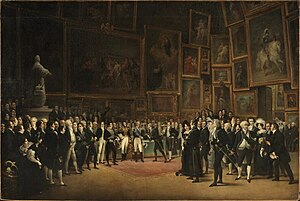


The Salon (French: Salon), or rarely Paris Salon (French: Salon de Paris [salɔ̃ də paʁi]), beginning in 1667[1] was the official art exhibition of the Académie des Beaux-Arts in Paris. Between 1748 and 1890 it was arguably the greatest annual or biennial art event in the Western world. At the 1761 Salon, thirty-three painters, nine sculptors, and eleven engravers contributed.[2] From 1881 onward, it was managed by the Société des Artistes Français.
In 1667, the royally sanctioned French institution of art patronage, the Académie royale de peinture et de sculpture[1] (a division of the Académie des beaux-arts), held its first semi-public art exhibit at the Salon Carré. The Salon's original focus was the display of the work of recent graduates of the École des Beaux-Arts, which was created by Cardinal Mazarin, chief minister of France, in 1648. Exhibition at the Salon de Paris was essential for any artist to achieve success in France for at least the next 200 years. Exhibition in the Salon marked a sign of royal favor.

In 1725, the Salon was held in the Palace of the Louvre, when it became known as SalonorSalon de Paris. In 1737, the exhibitions, held from 18 August 1737 to 5 September 1737 at the Grand Salon of the Louvre,[3] became public. They were held, at first, annually, and then biennially, in odd-numbered years. They would start on the feast day of St. Louis (25 August) and run for some weeks. Once made regular and public, the Salon's status was "never seriously in doubt".[4] In 1748 a jury of awarded artists was introduced. From this time forward, the influence of the Salon was undisputed.

The Salon exhibited paintings floor-to-ceiling and on every available inch of space. The jostling of artwork became the subject of many other paintings, including Pietro Antonio Martini's Salon of 1785. Printed catalogues of the Salons are primary documents for art historians. Critical descriptions of the exhibitions published in the gazettes mark the beginning of the modern occupation of art critic. The French salon, a product of the Enlightenment in the early 18th century, was a key institution in which women played a central role. Salons provided a place for women and men to congregate for intellectual discourse.
The French Revolution opened the exhibition to foreign artists. In the 19th century the idea of a public Salon extended to an annual government-sponsored juried exhibition of new painting and sculpture, held in large commercial halls, to which the ticket-bearing public was invited. The vernissage (varnishing) of opening night was a grand social occasion, and a crush that gave subject matter to newspaper caricaturists like Honoré Daumier. Charles Baudelaire, Denis Diderot and others wrote reviews of the Salons.
After the French Revolution of 1848 liberalized the Salon, far fewer works were refused. Medals were introduced in 1849.
The increasingly conservative and academic juries were not receptive to the Impressionist painters,[5] whose works were usually rejected, or poorly placed if accepted. The Salon opposed the Impressionists' shift away from traditional painting styles. In 1863 the Salon jury turned away an unusually high number of the submitted paintings.[6] An uproar resulted, particularly from regular exhibitors who had been rejected. In order to prove that the Salons were democratic, Napoleon III instituted the Salon des Refusés, containing a selection of the works that the Salon had rejected that year. It opened on 17 May 1863, marking the birth of the avant-garde. The Impressionists held their own independent exhibitions in 1874, 1876, 1877, 1879, 1880, 1881, 1882 and 1886.
In 1881 the government withdrew official sponsorship from the annual Salon, and a group of artists organized the Société des Artistes Français to take responsibility for the show.[1]
In December 1890, the leader of the Société des Artistes Français, William-Adolphe Bouguereau, proposed that the Salon should be an exhibition of young, not-yet-awarded, artists. Ernest Meissonier, Puvis de Chavannes, Auguste Rodin and others rejected the proposal and broke way to create the Société Nationale des Beaux-Arts, with its own exhibition, immediately referred to in the press as the Salon du Champ de Mars [7] or the Salon de la Société Nationale des Beaux–Arts.[8] Soon, it was also widely known as the Nationale.
In 1903, in response to what many artists at the time felt was a bureaucratic and conservative organization, a group of painters and sculptors, led by Pierre-Auguste Renoir and Auguste Rodin, organized the Salon d'Automne.
As the number of salons increased, American newspapers sometimes referred to the original salon as the Salon of the Champs Elysees.[9]
|
Other salons
|
At the opening of the Salon of the Champs Elysees--the only salon conferring official honors--a painting by a new American artist was favorably noticed.